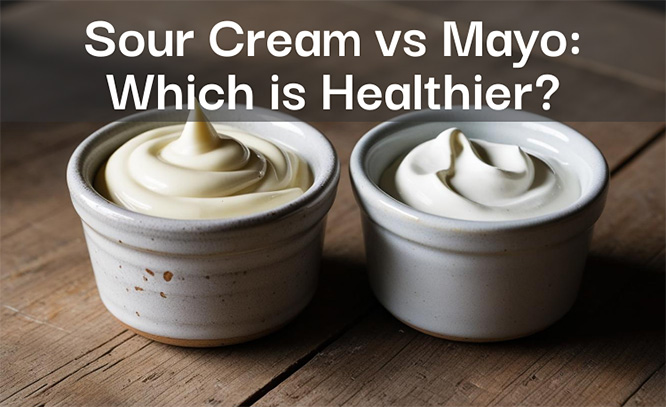I know they look kind of similar — creamy, white, and thick — but sour cream and mayo aren’t the same thing. And no, sour cream doesn’t have mayo in it. They just happen to show up in some of the same recipes, like dips, dressings, and sandwiches.
Still, when you’re trying to make healthier choices or cut back on calories, it’s normal to wonder: which one’s better for you — sour cream or mayo?
This post breaks it all down — from a straight-up health comparison using real products to how they differ in taste, texture, and everyday use.
Quick Answer: Which One’s Healthier?
Sour cream is generally healthier than mayo — it has fewer calories and less fat per serving. If you’re choosing between the two and trying to eat lighter, sour cream is the better option.
What’s the Real Difference Between Sour Cream and Mayo?
We’ve already cleared up that they’re not the same thing, but what actually sets them apart?
- Taste: Sour cream has a tangy, slightly sharp flavour thanks to the fermentation. Mayo is milder, smoother, and more neutral — it adds creaminess without the zing.
- Texture: Both are thick, but mayo is silkier and glossier, while sour cream has a bit more body and a spoonable consistency.
- How they’re used: Sour cream works well in dips, baked potatoes, and anything that needs a cool, tangy contrast. Mayo is more common in sandwiches, creamy dressings, and coleslaw — or anywhere you want richness without acidity.
Sour Cream vs Mayo: Real Brand Nutrition Comparison
To keep things realistic, let’s compare two popular UK products:
Tesco British Soured Cream and Hellmann’s Real Mayonnaise (Squeezy) — based on 100g of each.
| Nutrient | Tesco Sour Cream (per 100g) | Hellmann’s Mayo (per 100g) |
| Calories | 174 kcal | 725 kcal |
| Fat | 17.0g | 79g |
| Saturated Fat | 11.3g | 6.2g |
| Carbs | 2.7g | 1.4g |
| Sugars | 2.7g | 1.3g |
| Protein | 2.6g | 1.1g |
| Salt | 0.06g | 1.2g |
What does this tell us?
This side-by-side makes it pretty clear — mayo is far richer, with more than four times the calories and fat of sour cream per 100g. If you’re trying to cut back on calories or overall fat, sour cream is the obvious winner.
The only area where mayo comes out slightly ahead is saturated fat — despite being much fattier overall, it’s lower in saturates than sour cream. That’s something to keep in mind if you’re specifically watching that.
And salt? Also much higher in mayo — around 20 times more than in sour cream.
Calories Per Tablespoon: A Quick Visual Comparison
Sometimes it’s easier to picture things in spoonfuls rather than 100g measurements. So here’s how they compare per tablespoon (roughly 15g):
- Sour cream: ~26 calories
- Mayonnaise: ~109 calories
So if you’re adding a spoonful to your baked potato or sandwich, mayo gives you over four times the calories of sour cream. That adds up quickly if you’re using more than one.
What About Light Versions — Are They Really Better?
If you’re trying to cut back even more, you might be tempted to grab the “light” versions of sour cream or mayo. And yes — they do tend to have fewer calories and less fat. But there are a few things worth knowing.
- Light sour cream usually has around 40–50% fewer calories than the regular version. Some brands go as low as 100 kcal per 100g — that’s around 15 calories per tablespoon.
- Light mayo varies more. Some versions cut the calories in half, while others only drop it slightly. It often lands somewhere between 280–450 kcal per 100g, depending on the brand.
But here’s the catch: light mayo often contains added starches, sugar, or gums to keep the texture creamy. So while it may be lower in fat, it’s not always the most natural option.
If you want something lighter and closer to whole food, light sour cream usually keeps things simpler ingredient-wise. Or, if you want a real swap, plain Greek yogurt is a solid alternative to both.
So… Which One Should You Use?
If you’re aiming for something lighter with fewer calories, sour cream is the better option. It works especially well in things like baked potatoes, dips, or as a topping where that tangy flavour adds something extra.
Mayo, on the other hand, is richer and creamier — perfect for sandwiches, salad dressings, or recipes that need that smooth, neutral texture. But it’s also the heavier choice, so if you’re watching calories, it’s one to use sparingly.
And if you want something even healthier? Plain Greek yogurt is a great substitute for either. It’s high in protein, low in fat (if you go for low-fat versions), and works in most recipes where you’d use sour cream.

